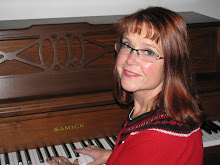Activity:
Practice counting with fingers
Hold up one hand with your palm facing your child. Point to and count each finger. Hold up a few fingers and say the rhyme (below), inserting the number of fingers you are holding up into the words. Point to and count each finger, inviting your child to count along on their own fingers
Hickety Pickety Buttercup
(by Linda Swears)
Hickety pickety buttercup,
How many fingers do I hold up?
(Three) it is and (three you say.
Please play (three) for us today.
ONE, TWO THREE!
How many fingers do I hold up? What else can we count? Point out noses, elbows, shoes, toys, etc.
Teaching about Numbers and Counting
(Notes for teachers and parents)
Taken from: Ed.Gov: U.S. Department of Education Teaching Our Youngest: A guide for preschool teachers and child care and family providers, http://ping.fm/R4QA2
Many children enter preschool with some knowledge of numbers and counting. They can count five to ten objects accurately and can also read some numbers. But many other children have not developed this knowledge. These children in particular need many opportunities to learn the words for numbers, to count things, and to learn to read and write numbers.
Parents:
You can help your children to learn about numbers and counting in many ways, including these informal ways:
- Make pointing to and counting objects part of your daily routines.
- As you pass out the juice cups at snack time, point and count the cups; as you pass out pieces of paper for an art project, point to the paper and count the pieces; count boots as you help take them off; count the stairs as you walk down them.
- As you point and count, get your child to count with you. Children need to hear and practice things a lot in order to learn them.
Teacher Talk
- Let's all count the pictures on the wall.
- Help the children learn to answer the "how many?" question.
- Let's count the puzzles on this table.
- Now let's count the games on the table.
Parents:
- Children like to point to and count their fingers, their legs, and their ears. Help them do that.
- Use different types of macaroni. Encourage them to sort the different types and then count them.
- Have materials on a choice shelf such as rubber teddy bears and colored cotton balls.
- Give children rulers and let them measure different things around the room.
- Teach the children counting songs and rhymes. You can play counting games with many different actions such as jumping and clapping. As children learn number words, they can count more actions.
- As you and the children sing counting and rhyming songs you can add and take off felt board pieces that represent objects in the song.
Teacher Talk
- We're going to clap three times. (The children clap three times, counting for each clap.) How many times did you clap? (The children say, "Three times.")
- We're going to jump five times. (The children jump five times counting each jump.)
- I am going to clap and I want you to listen for how many claps you here. OK, now you clap the same number I did.
Parents:
Here are some ways that you can help your children learn to recognize and write numbers:
- When they play with number puzzles, encourage them to say the numbers as they put the pieces in the puzzles.
- Have them include numbers in the pictures that they draw and in the words and "stories" that they write. For example, "What's the street number for your house that you drew?" "Wow, you wrote a long story. Can you number all of those pages?"
- Read and discuss number and counting books, pointing and counting the objects on each page.
- Encourage the children to make their own counting picture books by cutting and pasting pictures of objects on pieces of paper or by using stickers. The children can count the objects and write the number of the total on each page.
- Keep pencils, crayons and paper around the room so that the children can make lists.
- Using words such as same, different, more than, less than, and one more as you compare groups of objects.
- Naming the first, second, third, fourth, and last items when you talk about things in a line or a series. For example, when cooking, ask the children, "What do you think the first ingrediant will be? Ok, what is the second thing we should add to the bowl?"
- Using location words: in back of, beside, next to, between.
- Teaching them to learn to recognize, name, and draw different shapes, and by combining some shapes to make new or bigger shapes.
- Making comparisons between objects: taller than, smaller than.
- Measuring things first with measures such as string or strips of paper and then with rulers, scales and measuring cups and discussing why we need to measure things.
- Arranging groups of objects according to size-from largest to smallest.
- Helping them learn to copy patterns and to predict what will come next.
- Matching objects that are alike.
- Describing similarities and differences among objects.
- Sorting objects into groups by a given feature (the same color, the same shape) or by class (animals, cars, buildings). Discuss why the groups of objects are the same.


No comments:
Post a Comment